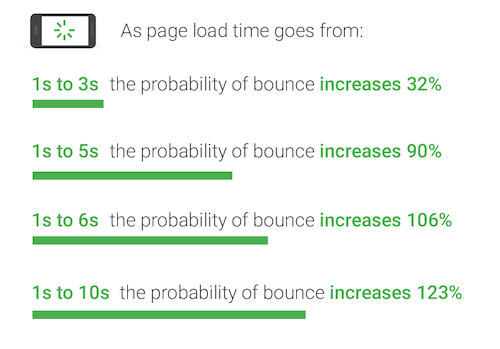The following was posted by Oliver Armstrong, VP of Product, Instapage. Learn more about Instapage’s AMP integration on their blog.
You don’t have to be an advertiser to know that mobile ad experiences are lacking. According to research from Google and SOASTA, the average load time for mobile landing pages is 22 seconds. For more than half of people who click through mobile ads, that’s at least 19 seconds too long:
And as load time grows, so does the number of people who abandon a page:

Back in February, Instapage’s Senior Director of Engineering Piotr Dolistowski and I spoke at AMP Conf on How to Balance AMP Limitations with Optimization Features. During the presentation we announced our plans to build AMP functionality within the Instapage platform. Fast forward to today, and we are pleased to report that advertisers can now build fast post-click experiences faster than ever by combining the AMP framework with Instapage.
The post-click experience
Before internet advertising, ads delivered revenue. Prospects watched TV commercials, read print ads, and determined whether or not they wanted what you were selling. If your ad sold the product well, they’d call to purchase or mail a check for your product. Today on the internet, that’s not the case.
The ad doesn’t do the selling anymore. The ad is only the gateway to what does the selling: the landing page. Here lies the difference between the pre-click and post-click experience:
- The pre-click experience: Everything that affects whether or not somebody clicks through your ad. These are things like platform, location, copy, media, targeting, etc.
- The post-click experience: Everything that affects whether those who click through convert. These are things like visual hierarchy, message match, load time, trust indicators, etc.
Recent numbers have shown that search advertising service AdWords click-through rates leave much room for improvement, at an average of 3.17%. And while pre-click experiences can be further optimized, post-click experiences have lagged behind significantly.
The average AdWords conversion rate across industries is 3.75%. That means around 97% of people aren’t clicking your ad, and of the 3% who are, more than 96% aren’t converting.
To address this gap between the ad and landing page on mobile, Google and others spearheaded the development of the open-source Accelerated Mobile Pages project (AMP). Three years later, it’s become clear that one of the easiest and most effective ways to boost mobile landing page conversion rate is by improving load time.
AMPifying your pages: What search advertisers stand to gain
From preliminary research done by Google and SOASTA, we can safely assume that with faster landing page load times come more conversions. If 53% of your visitors don’t get to see your landing page because it loads in over 3 seconds, then you’ve lost more than half your opportunities to earn a conversion. Even with a stellar landing page, you can’t convert visitors you don’t have.
However, a safe assumption is still an assumption. Luckily, now that 31 million domains have used AMP to speed their pages, we have some data to back up the hypothesis.
In a Forrester Consulting study commissioned by Google, AMP publishers are seeing a 20% increase in sales conversion rate, 10% year-over-year increase in AMP site traffic, and 60% increase in pages per visit. Certainly, numbers any advertiser would love to achieve.
The trouble is, while building a landing page with AMP is quick and easy, building one for every campaign isn’t. And reusing a landing page for a different campaign can deter visitors just like a slow-loading one can. The reason is because it won’t have message match.
What is message match?
The landing page is where conversions happen. And just as speeding your load time can quickly boost conversion rate, so can ensuring that the message of your landing page matches the message of your ad with:
- Similar colors
- Identical logos
- The same media
- Matching headlines
Conversions start with a foundation of trust, and message match establishes it by letting visitors know they’re in the right place. However, when you’re constantly running and testing new campaigns, it’s tough to customize every landing page to match every ad.
The middle ground
When advertisers need something quick-loading, quick to build, and fully customizable, now they can turn to Instapage’s new AMP functionality.
Using the most robust post-click optimization platform, you can pick a template and click to edit elements, drag to place them, and publish your accelerated mobile landing page faster than ever.
Where there was once a trade-off between quality and quantity, there is no longer. Today, you can quickly create landing pages with all the ingredients of a persuasive landing page:
- No navigation
- An attention-grabbing, message matched headline
- Engaging media
- Skimmable, benefit-oriented copy
- Trust indicators like social proof and security badges
- A compelling call-to-action
Today, when the ad alone can’t convert, every campaign needs its own landing page. By combining AMP and Instapage, you maximize opportunities for conversion by keeping visitors from bouncing, and compelling them to click your CTA. Go here to get started building AMP-compliant pages in Instapage.
Oliver Armstrong, VP of Product, Instapage. Learn more about Instapage’s AMP integration on their blog.